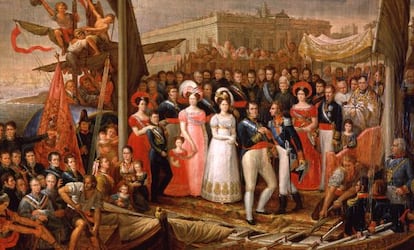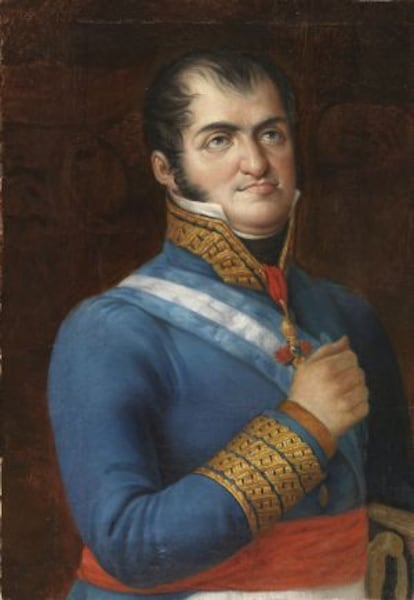Spanish royal painting thought lost for 100 years resurfaces in Madrid
The vast canvas, which features Ferdinand VII, was believed to have burned in a fire in 2015 Now 21 fragments of the work have been uncovered in the capital's Cerralbo Museum

One hundred years after it was presumed lost in a fire, an early 19th-century painting depicting one of Spain’s least-popular monarchs has resurfaced in a Madrid museum, albeit in fragments.
Painted in 1827 by José Aparicio Inglada, El desembarco de Fernando VII en el Puerto de Santa María (The disembarkation of Ferdinand VII at Puerto de Santa María), measuring seven meters by four meters, was assumed to have been destroyed along with other artworks when a fire swept through the capital’s Palace of Justice in 1915. The work had been handed to the Spanish justice ministry by the Prado Museum in 1883.
The 28-square-meter work depicts the entire royal family and more than 80 other figures from the time
But researchers preparing an exhibition that opens at the Supreme Court on September 10 to mark the anniversary of the fire have unearthed the canvas – now cut into 21 sections – in the Cerralbo Museum in Madrid. Pilar Tébar, an art historian at the University of Alicante, recognized historical figures in several of the fragments from photographs of other portraits by Inglada.
The Spanish Culture Ministry says the painting had been bought by Enrique de Aguilera y Gamboa, Marquis of Cerralbo from an art dealer in Madrid’s Rastro flea market. The 28-square-meter work depicts Ferdinand VII, along with the entire Spanish royal family and more than 80 other political and historical figures from the time. The Marquis of Cerralbo donated his art collection to the Spanish state in 1922.

Known as the “felon king,” Ferdinand VII (1784-1833) ruled twice: first in 1808, when he was overthrown by Napoleon, and again from 1813 to his death. Following the defeat of France, he reestablished an absolute monarchy and rejected the liberal constitution drawn up in 1812. After he died, Spain was plunged into a civil war.
The exhibition in the Supreme Court will include two fragments of the painting that have been restored by the Prado Museum: one depicting Ferdinand himself and another of his wife, Queen Maria Josepha Amalia of Saxony.
Nothing is known about how the painting was rescued from the blaze in the Palace of Justice, or how it ended up in the Rastro, but researchers believe that it was cut up to make portraits out of the many figures featured in it, which were presumably to have been sold to their families. They also venture that the Marquis of Cerralbo may have segmented it to remove Carlos María Isidro, an ultra-conservative pretender to the Spanish throne, from the scene – the Marquis supported the Carlist claim to the crown. The Carlists backed Don Carlos, Count of Molina (1788–1855), a separate line of the Bourbon dynasty. Carlism remained a force in Spanish politics up until the death of General Francisco Franco in 1975.
When the palace burned
Madrid’s Palace of Justice was rebuilt after the fire of May 4, 1915, and is now the seat of the Supreme Court. A series of events to commemorate the event are being held over the coming months that will include conferences, debates, and even an exhibition for children explaining the country’s justice system.
Shortly after midday on May 4, a fire broke out in the upper stories of the Palace of Justice, which was soon engulfed by smoke and flames. The alarm was sounded by an eight-year-old boy, Gregorio Valle, whose family lived opposite. Hundreds of people gathered in Salesas square where the Palace of Justice is located to watch as the building was consumed by fire.
Dozens of ushers, judges, lawyers and other officials, including the families of court employees, who lived in the attics of the building poured out on to the street. Prisoners held in the basement cells were also rescued. Maria Christina of Austria, the queen mother, who was passing by in her car, stopped to watch the spectacle. King Alfonso XIII interrupted his shooting expedition in woodland northwest of the capital to attend the scene and organize the rescue of documents.
A troop of boy scouts were among those who helped firefighters using mule-drawn water pumps put out the blaze, but their efforts were to no avail.
The only victim of the fire was a court official, José María Armada, who went back into the building to try to rescue papers in his office. He was given a hero’s funeral, attended by government representatives. The photographs taken of the event by Alfonso, the best-known photo-journalist of his day, are also included in the exhibitions marking the fire’s 100th anniversary. A ceremony will also be held to pay homage to the boy scouts who helped try to put out the blaze.
Tu suscripción se está usando en otro dispositivo
¿Quieres añadir otro usuario a tu suscripción?
Si continúas leyendo en este dispositivo, no se podrá leer en el otro.
FlechaTu suscripción se está usando en otro dispositivo y solo puedes acceder a EL PAÍS desde un dispositivo a la vez.
Si quieres compartir tu cuenta, cambia tu suscripción a la modalidad Premium, así podrás añadir otro usuario. Cada uno accederá con su propia cuenta de email, lo que os permitirá personalizar vuestra experiencia en EL PAÍS.
¿Tienes una suscripción de empresa? Accede aquí para contratar más cuentas.
En el caso de no saber quién está usando tu cuenta, te recomendamos cambiar tu contraseña aquí.
Si decides continuar compartiendo tu cuenta, este mensaje se mostrará en tu dispositivo y en el de la otra persona que está usando tu cuenta de forma indefinida, afectando a tu experiencia de lectura. Puedes consultar aquí los términos y condiciones de la suscripción digital.
Últimas noticias
Most viewed
- Pablo Escobar’s hippos: A serious environmental problem, 40 years on
- Why we lost the habit of sleeping in two segments and how that changed our sense of time
- Charles Dubouloz, mountaineering star, retires at 36 with a farewell tour inspired by Walter Bonatti
- Reinhard Genzel, Nobel laureate in physics: ‘One-minute videos will never give you the truth’
- The Florida Keys tourist paradise is besieged by immigration agents: ‘We’ve never seen anything like this’








































